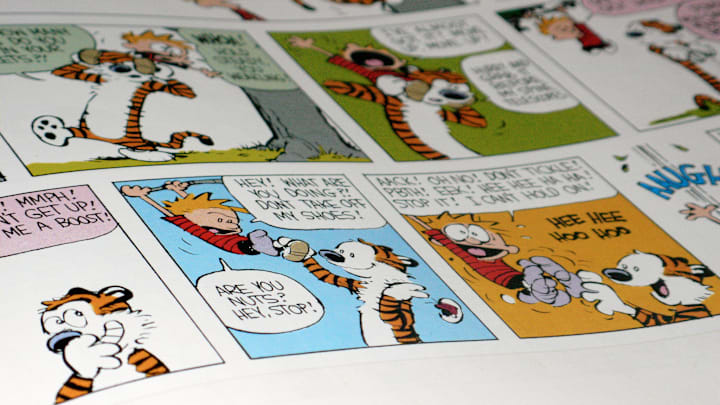Though we can’t pick your friends, we strongly encourage you to ostracize anyone who expresses disinterest or disdain for Calvin and Hobbes, the brilliant comic strip illustrated by Bill Watterson from 1985 to 1995. For the December 2013 issue of mental_floss magazine, we scored a rare interview with the famously private Mr. Watterson. Here are seven more notes about the author, the boy, and his stuffed tiger. Tuna fish sandwich and toboggan optional.
1. Watterson to Spielberg and Lucas: Thanks, but no thanks.
Lee Salem, Watterson’s editor at Universal Press Syndicate, recalls fielding several calls in the 1980s from a who’s who of celebrities and producers who wanted to either get in business with the author or just pass along their admiration for his work. At one point, both Steven Spielberg and George Lucas reached out asking to meet with Watterson, but the artist, who felt schmoozing and publicity took his focus away from the strip, politely declined.
Salem did, however, forward a fan letter to Watterson from Stephen King. The editor didn’t open it, but we’d like to think it expressed satisfaction at the numerous decapitated and suicidal snowmen that populated Calvin’s front yard over the years.
2. Calvin and Hobbes … and Robotman?
When Watterson was busy trying to find a home for Calvin and Hobbes in its earliest incarnation—the two were supporting characters in a strip titled In the Doghouse, about the grown-up struggles of Calvin’s older brother—United Feature Syndicate made the cartoonist an offer: Would he shoehorn an existing character, a sentient machine named Robotman, into some of Calvin’s fantasies? The syndicate had licensing deals cooking and was looking to get their intellectual property into newspapers to help push merchandise. Watterson, displeased with the crassly commercial nature of the request, refused. (Robotman got his own strip in 1985. And no, we don’t remember him, either.)
3. The Complete Collection isn’t quite complete.
To celebrate the strip’s 20th anniversary in 2005, publisher Andrews McMeel issued a hernia-inducing collection of Watterson’s entire body of work—sort of. Salem recalls a minor blow-up from readers when Watterson published two strips in the 1980s that depicted Calvin mocking the idea he might be adopted. In one strip, Calvin’s complains that “I’ll bet my biological mother would’ve bought me a comic book…” It was later changed to, “I’ll bet a good mother would’ve bought me a comic book…”
Another strip, featuring Hobbes in a washing machine, is missing from the collection entirely. Some have speculated that putting the tiger in a spin cycle might be an unwelcome hint he’s not real. No one, including Watterson, ever wanted to have that question answered.
4. Watterson did license. A little.
The persistent affection for Calvin and Hobbes is attributable in part to Watterson’s adamant refusal to water down his characters with toys, coffee mugs, and backpacks. While there was never a Garfield-esque empire of merchandising, he did occasionally offer his blessing for ancillary items. Calvin appeared on a Museum of Modern Art shirt commemorating an Ohio State University exhibition of comic art in 2001; two calendars, for 1989 and 1990, were issued; the book Teaching with Calvin and Hobbes was a tutorial intended to help students improve their language skills; finally, the duo mugged for a postage stamp in 2010, part of a Postal Service sheet of comic strip icons.
5. There was some urine trouble.
While any true fan of Calvin and Hobbes finds the ubiquitous, unauthorized car decal of Calvin peeing on automotive logos distasteful, at least one state took legal action: In the late 1990s, South Carolina slapped drivers sporting it with a ticket for $119, declaring it a violation of state decency law. In a 2005 Q&A with readers to promote the Complete collection, Watterson dryly noted that he “clearly miscalculated how popular it would be to show Calvin urinating on a Ford logo.”
6. Spaceman Spiff Was originally the whole idea.
When Watterson decided to exit a floundering career in editorial cartooning, he imagined a number of strips and circulated them amongst the syndicates. One of them, Spaceman Spiff, was intended to be a parody of the Star Wars space fantasy genre. “It was so bad,” Watterson told the Dallas Morning News in 1987, “that I make fun of it in Calvin.”
7. The last 'Calvin and Hobbes' strip wasn’t Watterson’s swan song.
Though he’s never returned to cartooning and only paints for his own satisfaction, Watterson did release a new piece of work in 2012: An oil-on-canvas depiction of Petey Otterloop, one of the characters in the comic strip Cul de Sac. Watterson donated the work to help raise funds for Parkinson’s research, a disease afflicting the strip’s author, Richard Thompson. Selling for over $13,000 at auction, it might just be the most affordable piece of Watterson art we’ll ever see: an original Calvin and Hobbes Sunday strip sold for a staggering $203,150 in 2012. Another sold for $480,000 in October 2022.
A version of this article ran in 2013; it has been updated for 2023.
